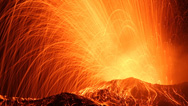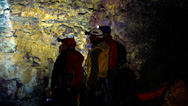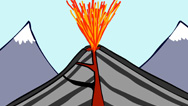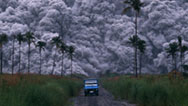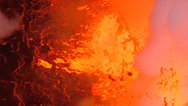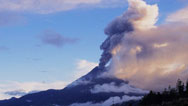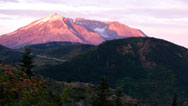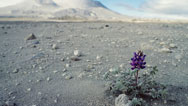
Doomsday Volcanoes
Could the explosion of Iceland's ticking time bombs cause cold and famine worldwide? Airing January 2, 2013 at 9 pm on PBS Aired January 2, 2013 on PBS
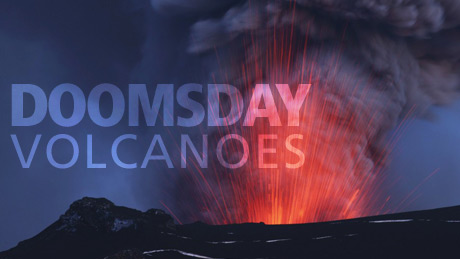
Program Description
Transcript
Doomsday Volcanoes
PBS Airdate: January 2, 2013
NARRATOR: A volcano awakens in Iceland. A mountain erupts, belching millions of tons of ash into the sky. Airlines soon feel the effect: a hundred thousand flights are cancelled; around 10 million passengers stranded.
FRED PRATA (Norwegian Institute for Air Research): Chaos: aircraft grounded, airlines going out of business.
SCIENTIST 1: It had an enormous impact for aviation, brought Europe to a standstill.
NARRATOR: The impact quickly spreads. Freight movement around the globe is crippled, costing the world's already fragile economy billions of dollars.
And now, scientists are discovering volcanoes in Iceland that can dwarf this eruption of ash in 2010, volcanoes that produce killer clouds of sulfuric acid, and, most alarming of all, a giant ice-covered volcano that that's overdue to erupt and that could threaten the entire planet.
ANJA SCHMIDT (University of Leeds): Nowadays, we are very vulnerable to volcanic eruptions.
IAN DAVIES (EasyJet): It's not a matter of if, it's when.
MIKE RAMPINO (New York University): Volcanoes can be considered a ticking time bomb.
JOHN GRATTAN (Aberystwyth University): I predict that we would see death tolls running into the hundreds of thousands.
NARRATOR: How threatening could the next eruption from Iceland be? Doomsday Volcanoes, right now, on NOVA.
Reykjavík: the world's most northern capital city, home to most of Iceland's 320,000 inhabitants. Over a thousand years ago, the Vikings settled this frozen land. Today, tourists flock here to marvel at Iceland's explosive geysers and boiling pools, but this abundant thermal energy has a darker side, its volcanic threat. In 2010, the volcano Eyjafjallajökull, nicknamed Eyja, explodes into life. The eruption lasts for over two months. Icelanders head for shelter, as the ash rains down.
But Eyja's effects are soon felt globally, when the ash cloud spreads into the busy routes of trans-Atlantic aircraft. Airports around the globe are gridlocked, as thousands of flights are cancelled. But scientists are concerned much worse could come from Iceland.
MIKE RAMPINO: I think we dodged a bullet with the 2010 eruption. In the future, there are going to be eruptions in Iceland much bigger than the 2010 event.
NARRATOR: These scientists are uncovering the devastating effects of past volcanic eruptions and trying to predict how widespread the deadly consequences of the next eruption could be.
Thor Thordarson is a volcanologist. He knows Iceland's volcanic threat well, having spent almost 30 years mapping its complex geology.
THOR THORDARSON (University of Edinburgh): The amazing thing about Iceland is that it has 30 volcanically active systems.
NARRATOR: Iceland is about the size of Kentucky. With so many live volcanoes in such a small area, it's one of the most volcanically active places on Earth.
But while Eyja sleeps again, three nearby volcanoes are cause for concern.
THOR THORDARSON: Since the eruption of Eyja, in 2010, we are keeping a close eye on three volcanoes: the Hekla volcano, Katla and Laki.
NARRATOR: Eyja's volcanic neighbors, Hekla, Katla and Laki, are clustered in a zone of intense volcanism in the south of the island.
Each has a distinct personality. Laki, a fissure volcano that tears across the landscape for 17 miles; she last erupted in 1783, wiping out a fifth of Iceland's population. Hekla, a menacing peak, almost 5,000 feet high; historically, she has erupted violently, without warning, belching vast amounts of ash. And Katla, a giant volcano, 18 miles across, hidden under 2,000 feet of ice. Katla is decades overdue for an eruption. She's currently rumbling, so volcanologists are most worried about her.
So why does Iceland have so many threatening volcanoes packed into such a small area? It's a result of its unique location.
Iceland lies in the North Atlantic, between North America, Greenland and Europe. Here, two of the Earth's crustal plates are being pulled apart, and Iceland straddles their boundaries. Below, is a hot spot, a huge upwelling of hot rock from deep within the Earth.
As the rock rises it produces magma. The magma forces through cracks in the crust, until it erupts at the surface, forming active volcanoes.
THOR THORDARSON: One of the reasons why it is difficult to predict volcanic eruption is that we are trying to predict the behavior of something we can't see. We can't see the magma, which is the source of these events.
NARRATOR: Aboveground, Eyja, Laki, Hekla and Katla appear to be separate volcanoes, but some scientists are starting to wonder if they might be linked underground, and that Eyja's recent eruption could have disturbed one of its neighbors.
Now, there's an astonishing place that helps reveal how volcanoes are linked.
FREYSTEINN SIGMUNDSSON (Nordic Volcanological Center): It's exciting to be here. It's quite unique to be able to go down into the crater.
NARRATOR: These geologists are about to take an incredible journey into the heart of a volcano. Seventy miles west of Eyja is Thrihnukagigur crater. It's a unique location that gives a tantalizing insight into how Iceland's volcanoes work.
FREYSTEINN SIGMUNDSSON: As we go down, it's quite narrow here. We just make it.
NARRATOR: After squeezing through the neck, they're confronted with an amazing sight: …
SIGRUN HREINSDÓTTIR (University of Iceland): Wow! Look at that.
FREYSTEINN SIGMUNDSSON: Yeah. It's beautiful.
NARRATOR: … a vast chamber, dropping 450 feet below the surface. Four thousand years ago, when the magma drained, the chamber remained remarkably intact. It's the only place on Earth where scientists can study a volcano from the inside.
FREYSTEINN SIGMUNDSSON: Amazing.
NARRATOR: Freysteinn is looking for evidence of how volcanoes like this are fed by molten rock. It's been something of a mystery, until now.
FREYSTEINN SIGMUNDSSON: Look at this. Can you see the fracture?
SIGRUN HREINSDÓTTIR: Wow. It's actually really cool how it goes up.
FREYSTEINN SIGMUNDSSON: This is an absolutely unique place. It is fantastic. We can see the fissures that fed magma into this volcano. This black line in the wall, it's a crack that delivered magma to the eruption. Now the magma is solidified in this fissure.
NARRATOR: This fissure acted like a giant vein, pumping magma into the chamber horizontally, as well as from deep below.
FREYSTEINN SIGMUNDSSON: What is so special is we can clearly see it, both sides.
NARRATOR: The fissure sliced right through the chamber and out the other side, and Freysteinn is working out which direction it took.
FREYSTEINN SIGMUNDSSON: If you trace it, you get the orientation of this crack.
NARRATOR: By lining up the fissure on either side of the chamber, the team finds the exact route it took and make an important discovery.
FREYSTEINN SIGMUNDSSON: What we have found is that they can go on for many miles. They're like thin sheets. They can link different volcanoes.
NARRATOR: So, although volcanoes appear isolated on the surface, fissures carrying magma, can link them underground. And that's an important consideration in trying to predict which of Iceland's volcanoes might erupt next.
Historically, Katla has erupted shortly after Eyja, on more than one occasion, suggesting hidden underground fissures could link them. If so, could Eyja's recent 2010 eruption be the trigger that sets off the giant ice-covered Katla again? Or one of her other volcanic neighbors? And what would be consequences?
Volcanoes are some of nature's biggest killers. They threaten us with torrents of molten lava, clouds of choking ash, mists of toxic gas. And, in the past, Iceland's inhabitants have suffered more than most.
In 1783, an eruption kills over 10,000 locals. It's one of the deadliest ever recorded, a killer that atmospheric scientist Anja Schmidt knows all about.
Fifty miles—mdash;80 kilometers—mdash;northeast of Eyja, lies the volcano Anja's interested in, the fissure called Laki.
ANJA SCHMIDT: We are standing on the Laki lava flows. So, as far as the eye can see, we can see the moss-covered lava flows from the 1783 Laki eruption. Just to give you a feeling for this scale, the area that these lava flows cover is actually 10 times the size of Manhattan.
NARRATOR: Why Laki produced so much lava is due to her volcanic character.
ANJA SCHMIDT: Laki has a very special sort of personality. It is very different in terms of eruption style, how it erupts, from other volcanoes. It's a so-called fissure eruption, which means it erupts along a linear vent system.
NARRATOR: A linear vent system works like this. Instead of erupting from a single crater, lava gushes along a line, where the fissure breaches the surface. In the United States, fissure eruptions are common on the Big Island of Hawaii, like this one, on Kilauea.
In 1783, Laki also erupted from a fissure, but on a vast scale. The earth opened up along a 17-mile fissure, spraying molten rock skywards.
ANJA SCHMIDT: Just imagine the earth's crust zips open, along a line.
If we were standing here, in 1783, witnessing the Laki eruption, it must have been a pretty frightening sight. The sky would have been black and dark, because the first volcanic ash fall had come down. And looking towards the actual eruption site, people could see fire fountains glowing red into the sky, rising up to one mile high, into the sky. And then you would have these lava flows slowly advancing, so you see incandescent, red, glowing lava flows in this darkened landscape.
NARRATOR: It sounds like a vision from Dante's Inferno, but, surprisingly, it wasn't lava that was the killer. It was something far more lethal, something that, if repeated in the 21st century, could affect millions around the globe.
In the heart of the English countryside, lies the disturbing evidence for this possible disaster. Here, in church records, forensic geoscientist John Grattan is uncovering clues that reveal just how far Laki's deadly eruption reached.
JOHN GRATTAN: So this is a parish record, and it contains the dates and names of people who have been buried here, which is what I'm particularly interested in. Using books like this, we can reconstruct patterns of mortality.
NARRATOR: Deaths normally occur in winter, when the old and ill succumb to cold weather. But John's uncovered a period of time, in 1783, where the records don't appear to make any sense.
JOHN GRATTAN: We see an intriguing change to that pattern, where people are dying in significant numbers in the summertime, when the weather is good, when there is plenty of food. So, we are interested in why this might be.
NARRATOR: Other accounts describe how the villagers are dying. They read like a horror story.
JOHN GRATTAN: In the foul, hot weather, in the beginning of summer, ulcerated mouths and eruptions on the lips and also pains in the face became epidemical. Burning fevers were accompanied by pleurisy and inflammation of the lungs. The burning fever and dysentery immediately came on us, in the center of England, and became epidemical in London, and there were some remarkable instances of sudden deaths.
NARRATOR: The killer's not only devastating the population, it's ravaging across the land.
JOHN GRATTAN: The barley became brown and weathered at the extremities, as did the leaves of the oats. All the different species of grain appeared to have all their leaves withered, exactly as if a fire had been lighted near them. And the occurrence of a tremendous thunderstorm seems to bring together everybody, thinking, "This is it. This is the end of the world!"
NARRATOR: But it isn't just England suffering. Vast areas of Europe experience the same calamity, as recorded by a founding father, living in Paris at the time.
JOHN GRATTAN: Benjamin Franklin noted, "There existed a constant fog over all of Europe…This fog was of a permanent nature. It was dry, and the rays of the sun seem to have little effect towards dissipating, as they easily do on moist fog arising from water."
And what this tells us is that this fog is not water vapor. It is something completely different.
NARRATOR: The killer is acting on a continental scale. The question is what is it?
Edinburgh, capital city of Scotland: In the University Labs, geologist Chris Hayward examines lava from Laki. He's looking for chemical clues that might identify Laki's killer.
CHRIS HAYWARD (University of Edinburgh): One of the most interesting things we can see in these lavas are these very tiny crystals. And what these do is record the chemistry of the magma, as it evolves, from the time when it forms, very deep under the ground, until it was erupted. So, they are like little time capsules.
NARRATOR: As the crystals grew, they entombed tiny pockets of Laki's magma inside them, along with its chemistry.
CHRIS HAYWARD: So here is one of the crystals, this dark area. And just here, you can see one of the little pockets of magma. And, if I zoom in, this is the thickness of a sheet of paper, just to give you an idea of how small these things are.
NARRATOR: Using a sophisticated electron microprobe, Chris teases out their chemistry and finds something intriguing.
CHRIS HAYWARD: We've discovered something very interesting. The material inside the crystals is pockets of magma that were trapped early on contain large amounts of sulfur.
NARRATOR: The crystals formed miles underground, when Laki's magma was relatively rich in sulfur. But when Chris analyses the solidified lava surrounding them, formed much later on, during Laki's eruption, he makes a remarkable discovery.
CHRIS HAYWARD: The final magma that froze in the lava, when it was erupted, contains almost no sulfur at all.
NARRATOR: So where did the sulfur go? It escaped from the rising magma as a gas, into the air.
CHRIS HAYWARD: We estimate that around 120 million tons of sulfur was released during the eruption.
NARRATOR: So could Laki's sulfur be responsible for the deaths in Europe and Iceland, in 1783? If so, how might it kill? Chemist Andrea Sella has the answer.
ANDREA SELLA (University College London): Sulfur is actually really very abundant. It's kind of up there in the top 20 elements in the earth's crust. And native sulfur actually often comes out of the ground in volcanic areas to give this wonderful lemon yellow material.
NARRATOR: It also has a very distinctive odor.
ANDREA SELLA: If we take a sample of commercial powdered sulfur and take the lid off and give it a quick sniff, it's got a delicate, almost evocative smell. It's something a little bit like a freshly sliced hardboiled egg. It's the kind of smell you often get near hot springs or thermal baths, something you associate with volcanism.
NARRATOR: Throughout history, sulfur's long been associated with boiling mud, volcanoes and hell.
ANDREA SELLA: It was brimstone, the devil. It was clearly a dangerous and powerful substance. And in order to show this, what I think we should do is to heat a little bit of sulfur up and see the incredible things it does.
As we warm it, it soon begins to melt. We're gradually getting this deep dark liquid. This is a little bit like travelling ever deeper into the bowels of the earth. And if we go down far enough, deep down in the magma, the temperatures are so high, the sulfur's actually transformed to a gas.
NARRATOR: And, as the magma rises, the gas escapes, explosively, as sulfur dioxide.
ANDREA SELLA: This is among the most dangerous stuff that a volcano can produce.
NARRATOR: Climate scientist Mike Rampino understands the threat from sulfur dioxide only too well. He's come to one of Iceland's major attractions, the thermal pools at Geysir, where water is volcanically heated in spectacular fashion.
MIKE RAMPINO: We are sitting in front of a hot pool, which is giving off water vapor and steam. But I can also smell and even taste an acrid gas, and that is the big problem with volcanoes: the amount of sulfur gases that they release into the atmosphere.
NARRATOR: The sulfur dioxide gas given off by these pools is nasty enough, but when it's pushed into the atmosphere during an eruption, it can become a far more lethal chemical compound.
MIKE RAMPINO: And the problem is when the sulfur dioxide reacts with water vapor it forms a little droplet of the acid, sulfuric acid, and so, up in the upper atmosphere, if enough sulfur is released by the volcano, you get this mist of sulfuric acid droplets.
NARRATOR: It's the same acid found in your car battery, and it's dangerous stuff.
ANDREA SELLA: Sulfuric acid, at lab strength is a really, really potent acid, in fact it's really something of a tiger. And if we were to take some flesh, a piece of meat like this, and then we can take some concentrated sulfuric acid and pour it on top, the results are going to be really unpleasant.
NARRATOR: Andrea's using concentrated sulfuric acid to show the grizzly effects it has on tissue.
ANDREA SELLA: Within seconds you start to see changes in the color in the surface of the flesh, and you can see it going from that happy dark red color to something much more beige-y brown.
So, what the acid does is react with the protein in the flesh. It's a little bit like cooking. What we've done, in effect, is that we've use the acid as a kind of tenderizer.
Wow, look at this. Here, we've got some meat, which has been in the acid for about 10 minutes. Wow.
And now we can really pull it apart. What we're ending up with is something truly horrific.
NARRATOR: Sulfuric acid formed from volcanoes is far more dilute, forming fine mists. Even so, it's something you wouldn't want to breathe.
ANDREA SELLA: Your lungs have some very, very delicate exposed tissue—mdash;they haven't got skin over the top—mdash;and the result is that anyone inhaling this mist is going to initially suffer some serious irritation. But there's going to be very, very long-term cumulative damage, if this goes on for any period of time.
NARRATOR: In 1783, Laki's fissure eruption lasted for eight months. Iceland's inhabitants didn't stand a chance against Laki's acidic cloud. And this cloud also killed hundreds of thousands more in Europe, according to John Grattan.
But how could an eruption in Iceland affect people across such a vast area, so far away?
JOHN GRATTAN: How on earth can these gases be concentrated sufficiently that you can taste them and smell them and that they will burn your eyes, over a 1,000 miles away?
NARRATOR: The answer to that lies not with Laki's eruption, but with the weather. During the last week of June, 1783, high pressure sweeps over northwest Europe, bringing fine summer weather. But it also allows something foul, high in the atmosphere, to sink downwards.
JOHN GRATTAN: That's where the volcanic gases are. Now they are being sucked down, dragged down to the earth's surface. And it is like a blowtorch, devastating the environment below it.
NARRATOR: The high pressure acts like a vast funnel. Air spiraling down from the upper atmosphere brings with it Laki's poisonous gases.
JOHN GRATTAN: If we were standing here, in 1783, the view behind us would have disappeared.
What we would see, instead, would be a blue haze, across the landscape. The color green would disappear, as the acids burned into the trees. The crops would have been burned, people dying, the birds dying, fish floating to the top of the ponds, because they have been killed, as well—mdash;really a view of Armageddon.
NARRATOR: It's the final link in the chain of events that triggers a volcanic catastrophe over Europe.
JOHN GRATTAN: One thing we do know, from the geological record, that events that have happened in the past will happen in the future. So the events of 1783, they will be repeated again.
NARRATOR: What nightmare scenario awaits us if that happens? If Laki's cloud reached Europe in 1783, how far could one stretch today?
Anja Schmidt has taken Laki's sulfur output from the 1783 eruption and, using a computer model, ejects it into today's atmosphere. It's a disturbing picture.
ANJA SCHMIDT: So the eruption starts in Iceland, and then, as you can see with the model, the sulfur spreads, so it crosses Britain, Germany, France and Spain. It's not only affecting Europe, but also North America. So, over the course of eight months, the entire northern hemisphere is filled with this sulfurous cloud, from one eruption, in Iceland.
NARRATOR: So how could that affect us? Already, many cities generate pollution that causes premature deaths from asthma, heart and lung disease. Could a toxic cloud from Iceland prove to be the tipping point?
Combining today's pollution with Laki's 1783 pollution, Anja estimates the extra deaths if the same volcanic acid cloud swept over Europe today.
ANJA SCHMIDT: Using our model, we can produce a kill map. What we find is tens of thousands of deaths in the U.K., in the Netherlands, in Germany, in France, all over central and western Europe. If we calculate the total across Europe, we find a mortality rate of more than 100,000 people. This is quite an astonishing number.
NARRATOR: Since her model shows that the cloud would eventually spread across the entire hemisphere, it's a stark warning of what we might expect in American cities.
But there's another threat from Iceland's volcanoes. Forty-five miles west of Laki is Hekla. At almost 5,000 feet, Hekla's distinctive cone towers above the landscape. She's one of Iceland's most active volcanoes, erupting over 20 times in the last thousand years.
Hekla last erupted in 2000, and recently her eruptions have been mild, but Thor's discovered a place that shows just how explosive she can be. And with Hekla, it's all about ash.
THOR THORDARSON: The snow-covered mountain in the background there is the Hekla volcano itself, and here in the foreground, this light-colored layer, at the top, was erupted from Hekla 3,000 years ago.
NARRATOR: These ash layers tell Thor a great deal about Hekla's explosive past.
THOR THORDARSON: The reason why we spend our time studying these ash layers is that we get information about the nature of the eruption, its intensity, its explosive power and how widely it effected the environment.
NARRATOR: He's discovered one particular eruption from Hekla, 3,000 years ago, threw out a tremendous amount of ash.
THOR THORDARSON: If you look at the landscape around us, all the surface is covered with ash, which is 15 feet thick. And it doesn't matter where you look, it's all around you. That gives you a good indication of how powerful and how strong that eruption was.
NARRATOR: Hekla's explosive eruptions created this barren landscape. It's made of layer upon layer of ash, formed from pulverized magma. And it's typical of Hekla's family of volcanoes, the stratovolcanoes.
THOR THORDARSON: Most stratovolcanoes around the world will produce big, explosive eruptions, every so often. Every so often, you get a big bang.
NARRATOR: It's exactly what happens in Washington State, in May, 1980. Mount St. Helens, America's most famous stratovolcano erupts. Rising magma triggers an earthquake and a vast landslide, sending ash 80,000 feet high, in just 15 minutes, and causing over 50 deaths.
Europe's most famous stratovolcano is Mount Vesuvius. When it erupted 2,000 years ago, gases and hot ashes rained down on the towns of Pompeii and Herculaneum, asphyxiating an unsuspecting population and killing up to 25,000 people.
But what Thor's discovered about Hekla's eruption 3,000 years ago, makes Mount St. Helens, Mount Vesuvius and Eyja's 2010 eruption pale in significance.
THOR THORDARSON: We have learned that this is one of the biggest eruptions of Hekla in the last 10,000 years, and the total volume of this material is between two and three cubic miles. It also sent ash plumes extending from Greenland well into mainland Europe.
If we were standing exactly in this location 3,000 years ago, when Hekla erupted, the first thing we would have seen is a humongous column of ash rising up from the volcano. And, from that plume, we have ash raining out, and, along with that, you would have rocks, like this one, here, flying through the air. This one is 20 pounds.
So this eruption, it would have killed you, and you would be buried in 15 feet of ash.
NARRATOR: When Eyja erupted, her ash grounded aircraft for almost a week, but Hekla could be far more disruptive. Three thousand years ago, Hekla produced 75 times more ash. The concern is she might be about to do it again.
THOR THORDARSON: The pattern we have detected is suggesting that right now is the end of a phase, with eruptions diminishing, indicating that we might be entering a new phase, which usually starts with a big explosive eruption.
So it's possible that Hekla might produce a very big, explosive eruption in the near future.
NARRATOR: What chaos might we expect if this happens? Claire Witham has been asking the same question.
She's part of a rapid response team at the London Volcanic Ash Advisory Centre at the U.K.'s Met Office. It's the first line of defense against volcanic ash for Europe's aviation industry. And when Eyja erupted, it put the team through their paces.
CLAIRE WITHAM (United Kingdom Met Office): We hadn't seen anything that had really blown an ash cloud from Iceland to our area in recent history, so it hadn't really got into people's minds that that might happen.
The Eyjafjallajökull eruption went on for about 39 days. People were working around the clock, here, on a scale we haven't really experienced before.
NARRATOR: The minute an eruption occurs, observers in Iceland contact the team.
CLAIRE WITHAM: We then have a race against time to get out an advisory. We then have to update that information every six hours until the end of the eruption.
NARRATOR: Claire needs two key things to predict where the ash cloud is going. First, she needs an accurate weather forecast.
CLAIRE WITHAM: The weather's really vital, because when the ash is erupted into the atmosphere, it then gets transported by the winds, at those higher levels, and gets taken wherever those winds are going.
NARRATOR: How forcefully the volcano erupted is also critical.
CLAIRE WITHAM: We need to know how high the eruption is and also how much has been emitted and how that changes with time.
NARRATOR: Armed with this information in 2010, Claire and her team used supercomputers to model the movement of ash from Eyja.
CLAIRE WITHAM: So, what we can see the start of the eruption, and then the ash is transported to the southeast and is then dispersed across the northern hemisphere.
NARRATOR: In the future, with the possibility of bigger eruptions, the team's predictions will be even more important.
To see what might happen, NOVA asks Claire to make a model using Hekla's huge eruption 3,000 years ago—mdash;which belched up to three cubic miles of ash—mdash;and the weather conditions when Eyja erupted in 2010.
CLAIRE WITHAM: So, this simulation shows the first-ever model run of a much larger eruption. And what we can see is that—mdash;because this eruption was much bigger, so it went much higher in the atmosphere and produced considerably larger amounts of ash—mdash;that the plume covers a much wider area, and the levels of ash in the plume are much greater—mdash;which is shown by this red color—mdash;spreading out over a much larger region of Europe and also across the northern hemisphere. And what this tells us is that, for a future eruption of a larger size, the potential for disruption is greater.
NARRATOR: What's worse is that we might not have time to prepare.
THOR THORDARSON: Hekla does not give us much warning. Her temperament is such that she'll flare up 30 minutes before she erupts. So, she can surprise us.
NARRATOR: As scientists are learning, Iceland's home to a group of deadly volcanoes: Ejya blew in 2010; Laki sent a toxic cloud of sulfur circling around the northern hemisphere; and Hekla, which could unleash billions of tons of ash without warning.
But the greatest threat is from their restless neighbor,…
MIKE RAMPINO: I would be more worried about a Katla-style eruption happening today.
NARRATOR: …one that volcanologists can't afford to ignore: …
THOR THORDARSON: The concern with Katla is that it might erupt any time.
NARRATOR: …the volcano hidden under the ice.
SCIENTIST 2: Katla's rumbling.
NARRATOR: Some fear her eruption could be worse than Laki's sulfur cloud and Hekla's ash put together.
Katla erupts every 50 years, on average. Her last major outburst was nearly a hundred years ago, so an eruption is long overdue.
THOR THORDARSON: All the signs that we detect from the volcano tell us that it is building up to an eruption.
NARRATOR: Recently, scientists have detected swarms of earthquakes around her crater. Whether this threatening activity is because Eyja's eruption has lit Katla's fuse, no one knows. To find out what's going on, Sigrun Hreinsdóttir and Freysteinn Sigmundsson are making the three-hour trip to the volcano's summit to set up monitoring stations.
SIGRUN HREINSDÓTTIR: We are driving up now, up to the glacier, and we will need a guide, because it's a fairly rough environment, and there are crevasses to worry about.
NARRATOR: It's a treacherous journey. Katla's crater is over six miles wide, buried below the ice.
Sigrun is looking for a specific site to set up one of her stations, somewhere where Katla's rim breaks though the ice.
SIGRUN HREINSDÓTTIR: Right on the top of the bedrock there.
The bedrock is the…actually the caldera rim, sticking right out of the glacier.
FREYSTEINN SIGMUNDSSON: What a fantastic sight.
NARRATOR: It's the perfect spot. This rocky outcrop connects to Katla's magma chamber, deep below. If the magma moves down there, so should the ground above it, here.
SIGRUN HREINSDÓTTIR: This is just a simple antenna that's receiving data from the satellites that are travelling, here, across the sky. And we hook the antenna to a receiver, and the receiver is logging the data.
NARRATOR: The satellites transmit signals to Sigrun's G.P.S. network, stationed around Katla's rim, providing an extremely accurate fix on their positions.
If Katla's magma chamber inflates, its rim pushes outwards, moving the receivers. Even a tiny shift of less than an eighth of an inch can be detected.
SIGRUN HREINSDÓTTIR: So magma, molten rock, is coming from great depth into the volcano. And what we have in a magma chamber—mdash;just like a balloon, if you imagine you put air in a balloon and it inflates—mdash;we can actually sense that on the surface.
NARRATOR: And there are indications that Katla's chamber is indeed inflating.
SIGRUN HREINSDÓTTIR: So, Freysteinn, we actually look at the data from the G.P.S. station, which is right here, at the Katla volcano. We set this up during the Eyja eruption. This is 2010, and now we are in 2012, and you see that the overall trend here is up, so inflation of the magma chamber is almost eight centimeters. Yes, it's quite a bit. The magma chamber of Katla volcano is inflating.
NARRATOR: The G.P.S. readings show Katla could be building to an eruption. So, what's the worst we can expect from her? Thor's been investigating layers of black ash the volcano ejected in 934. What he's uncovering alarms him.
THOR THORDARSON: So, here we have the lower part of the deposit. Here is the bottom, and it's fairly course-grained. This is the one thing that we really want to worry about. Explosive events, like this, produce a lot of ash.
NARRATOR: Volcanologists have measured the thickness and extent of these ash layers, allowing them to calculate the volume of material Katla erupted a thousand years ago.
THOR THORDARSON: The results tell us that the 934 eruption of Katla, in terms of volume of material, is double the Hekla eruption 3,000 years ago.
NARRATOR: The closest we've come to experiencing an eruption on that scale rocked the Philippines in 1991, when Mount Pinatubo erupted. This, one of the largest eruptions in modern history, lasted for just over a week, sending an estimated 2.5 cubic miles of ash into the atmosphere.
But Katla's ash reveals she can erupt for far longer.
THOR THORDARSON: There are many, many, many layers there. That means that this eruption featured many, many explosive events. It's a complex eruption; it probably lasted for at least one year.
NARRATOR: If a yearlong eruption of ash weren't threatening enough, Katla also spewed 220 million tons of sulfur, much more than Laki in 1783.
THOR THORDARSON: It is double that of Laki. So it is the biggest eruption in Icelandic history, and it is the biggest volcanic pollutant in recent times on planet Earth.
NARRATOR: It's this acidic pollution that scientists fear the most. If Katla erupts today, the devastation could trump the effects of Eyja, Laki and Hekla combined. And the amount of sulfur produced would be far worse.
MIKE RAMPINO: Well, sulfur has a double whammy effect when it's in the atmosphere. The little droplets of sulfuric acid, or aerosol as it's called, stay in the upper atmosphere and cut out some of the sunlight that comes in to warm the earth. And the result is that the earth gets cooler.
NARRATOR: Katla has the power to change the world's climate.
MIKE RAMPINO: A long-duration eruption, such as Katla, if it happened today, would cause quite a mess on a global scale. The numbers are about two degrees Celsius cooler. It doesn't sound like much, but it is enough to cause a transformation of the landscape.
NARRATOR: The evidence is clear. Iceland's volcanic eruptions could have global consequences, producing enough ash and sulfur to change the world's climate. But could we protect our economy, if a less powerful eruption, like Eyja in 2010, occurs in the near future?
It's a vital question for the airline industry, as aircraft will be the first to feel the effects. At 35,000 feet, ash particles are so fine they are invisible to the naked eye, so when Eyja erupted, thousands of planes were immediately grounded.
It's a problem aircraft engineer Ian Davies has been grappling with.
IAN DAVIES: Well, we know ash and engines don't mix, because this modern turbo fan engine, behind me, basically, takes in hundreds of cubic meters of air every second.
NARRATOR: Any volcanic ash sucked into the engine, which heats up to 2,000 degrees Fahrenheit, melts and sticks to vital parts.
IAN DAVIES: And when it does that, it will cause a surge stall, which is, effectively, a backfire, and, in doing so, we can get flames out front and the back of the engine, and, ultimately, it will shut down.
NARRATOR: Fred Prata, an imaging expert, is developing a unique system that could help. It's called AVOID.
FRED PRATA: This instrument, here, is a fast-sampling dual-camera system, measuring the infrared. Infrared radiation is heat. Every molecule in the atmosphere that's vibrating emits infrared radiation.
NARRATOR: Ash particles also emit infrared radiation at a particular wavelength.
FRED PRATA: Now, they have a particular spectral signature in the infrared, which is quite different to that of other things in the atmosphere, like water clouds, ice clouds, water vapor.
NARRATOR: The cameras, which can pick up infrared signatures, provide pilots with a picture of the sky up to 60 miles, allowing them to distinguish between ash and clouds.
FRED PRATA: So now he can start to see where the ash is. If it is there, and he sees it five or six minutes ahead of time, he can then make a small deviation and avoid it completely, safely and economically and land his aircraft.
NARRATOR: The new system could be the first step towards keeping planes in the air when ash next rises from Iceland. And it could help pilots map and maneuver around invisible ash clouds while they're flying, even reducing the need to ground planes.
Still, the greatest threat would come not from Katla's ash, but from her toxic sulfuric acid cloud. Faced with a giant volcanic eruption today, a major response would be needed to protect us.
JOHN GRATTAN: But how would they do that? They would do that by inconveniencing us, they would do that by switching off the power stations that might be burning coal; they might stop us driving cars that are emitting pollution from the engines; they would do that by closing factories down.
MIKE RAMPINO: I think modern day society should very much be concerned with volcanism.
CLAIRE WITHAM: I think we're probably more susceptible to these types of events in the 21st century than we are in the early 20th century.
JOHN GRATTAN: We think we're immune to these things, and, frankly, we're not.
NARRATOR: Those least able to protect themselves would be most affected.
JOHN GRATTAN: To be brutal about it, the vulnerable population will be culled from society. The elderly, the sick, people with heart and lung conditions, the obese. We are going to see many, many people dying.
NARRATOR: Today we have a society dependent on air travel,…
IAN DAVIES: The way we move food, freight, people around the world now, any disruption to that is devastating.
NARRATOR: …a society that's delicately linked together.
JOHN GRATTAN: So, a massive volcanic eruption is really going to disrupt this web of connectivity. All those networks are going to be fractured; they're not going to work anymore.
NARRATOR: Lives were thrown into chaos when Eyja, a relatively small volcano, awoke in 2010. How much worse will it be if and when one of Iceland's doomsday volcanoes erupts?
Broadcast Credits
- PRODUCED AND DIRECTED BY
- Duncan Copp
- EDITED BY
- Christy Hanna
- EXECUTIVE PRODUCER
- Alex Sutherland
- CAMERA
- Jay Dacey
Toby Wilkinson
Keith Ingram - SOUND RECORDISTS
- Stephen Horwood
Skuli Helgi Siguergislason - NARRATED BY
- Demetri Goritsas
- VISUAL EFFECTS
- DSP VFX
- PRODUCTION MANAGER
- Pete Hirst
- ONLINE EDITOR
- Jean-Paul Vial
- COLORIST
- Mike Curd
- AUDIO MIX
- Adam Wood
- ASSISTANT PRODUCER
- Ed Watkins
- PRODUCTION SECRETARY
- Emily Wilkinson
- ARCHIVE RESEARCH
- Jack Penman
- ARCHIVAL MATERIAL
- Ágúst Guðbjörnsson
AP Archive
ARTIOS FILMS
Clipcanvas
Framepool
Getty Images
NASA
Peter Cox
Peter Vancoillie
Pond5
Sean Stiegemeier
SuperStock
Tropical Visions
USGS
WGBH - SPECIAL THANKS
- Broadway Tower
Sheila Wilkes
St. Barnabas Church - NOVA SERIES GRAPHICS
- yU + co.
- NOVA THEME MUSIC
- Walter Werzowa
John Luker
Musikvergnuegen, Inc. - ADDITIONAL NOVA THEME MUSIC
- Ray Loring
Rob Morsberger - POST PRODUCTION ONLINE EDITOR
- Spencer Gentry
- CLOSED CAPTIONING
- The Caption Center
- MARKETING AND PUBLICITY
- Karen Laverty
- PUBLICITY
- Eileen Campion
Victoria Louie - SENIOR RESEARCHER
- Kate Becker
- NOVA ADMINISTRATOR
- Kristen Sommerhalter
- PRODUCTION COORDINATOR
- Linda Callahan
- PARALEGAL
- Sarah Erlandson
- TALENT RELATIONS
- Scott Kardel, Esq.
Janice Flood - LEGAL COUNSEL
- Susan Rosen
- DIRECTOR OF EDUCATION
- Rachel Connolly
- DIGITAL PROJECTS MANAGER
- Kristine Allington
- DIRECTOR OF NEW MEDIA
- Lauren Aguirre
- POST PRODUCTION ASSISTANT
- Brittany Flynn
- POST PRODUCTION EDITOR
- Rebecca Nieto
- POST PRODUCTION MANAGER
- Nathan Gunner
- COMPLIANCE MANAGER
- Linzy Emery
- BUSINESS MANAGER
- Elizabeth Benjes
- DEVELOPMENT PRODUCER
- David Condon
- PROJECT DIRECTOR
- Pamela Rosenstein
- COORDINATING PRODUCER
- Laurie Cahalane
- SENIOR SCIENCE EDITOR
- Evan Hadingham
- SENIOR PRODUCERS
- Julia Cort
Chris Schmidt - SENIOR SERIES PRODUCER
- Melanie Wallace
- MANAGING DIRECTOR
- Alan Ritsko
- SENIOR EXECUTIVE PRODUCER
- Paula S. Apsell
Produced by Darlow Smithson Productions Ltd. for NOVA/WGBH Boston in association with Channel 5
© 2013 Darlow Smithson Productions Ltd.
All rights reserved
Additional Material © 2013 WGBH Educational Foundation
Image
- (Eyjafjallajökull eruption, Iceland)
- © Stocktrek Images/Corbis
Participants
- Ian Davies
- EasyJet
- John Grattan
- Aberystwyth University
- Chris Hayward
- University of Edinburgh
- Sigrun Hreinsdottir
- University of Iceland
- Fred Prata
- Norwegian Institute for Air Research
- Mike Rampino
- New York University
- Anja Schmidt
- University of Leeds
- Andrea Sella
- University College London
- Freysteinn Sigmundsson
- Nordic Volcanological Center
- Thor Thordarson
- University of Edinburgh
- Claire Witham
- UK Met Office
Preview | 00:30
Full Program | 52:52
Full program available for streaming through
Watch Online
Full program available
Soon

